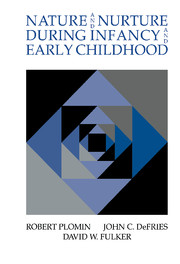Book contents
- Frontmatter
- Contents
- Preface
- Acknowledgments
- 1 Introduction
- 2 Individual differences and group differences
- 3 Quantitative genetics as the basis for a general theory of individual differences
- 4 The Colorado Adoption Project
- 5 Transitions and changes: description and prediction
- 6 Transitions and changes: genetic and environmental etiologies
- 7 Introduction to model fitting
- 8 Fitting sibling and parent–offspring models in the Colorado Adoption Project
- 9 Interactions
- 10 Genotype–environment correlation
- 11 Genetics and measures of the family environment: the nature of nurture
- 12 Conclusions
- References
- Author index
- Subject index
11 - Genetics and measures of the family environment: the nature of nurture
Published online by Cambridge University Press: 15 October 2009
- Frontmatter
- Contents
- Preface
- Acknowledgments
- 1 Introduction
- 2 Individual differences and group differences
- 3 Quantitative genetics as the basis for a general theory of individual differences
- 4 The Colorado Adoption Project
- 5 Transitions and changes: description and prediction
- 6 Transitions and changes: genetic and environmental etiologies
- 7 Introduction to model fitting
- 8 Fitting sibling and parent–offspring models in the Colorado Adoption Project
- 9 Interactions
- 10 Genotype–environment correlation
- 11 Genetics and measures of the family environment: the nature of nurture
- 12 Conclusions
- References
- Author index
- Subject index
Summary
Everything psychologists measure in the family environment is at least indirectly a measure of parental behavior. This is obvious for the two “superfactors” parental warmth and control, but it is just as true for physical aspects of the home environment such as number of books in the home. Consider, for example, the most widely used measure of the family environment, Caldwell and Bradley's (1978) Home Observation for Measurement of the Environment (HOME). Each of the 45 items clearly involves parental behavior; for example, the first item is “mother spontaneously vocalizes to child at least twice during visit.” The six scales of the HOME also indicate the behavioral nature of the HOME: emotional and verbal responsivity of the mother, avoidance of restriction and punishment, organization of the physical and temporal environment, provision of appropriate play materials, maternal involvement with child, and opportunities for variety in daily stimulation.
If measures of the home environment are viewed as indirectly assessing parental behavior, variations in such parenting measures can be studied from a quantitative genetic perspective. This perspective leads us to investigate the etiology of differences in childrearing behavior among parents and to consider genetic as well as environmental components of variance. Genetic variance can lead to variability on a measure of parenting for two reasons.
- Type
- Chapter
- Information
- Nature and Nurture during Infancy and Early Childhood , pp. 271 - 313Publisher: Cambridge University PressPrint publication year: 1988



